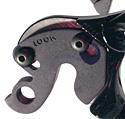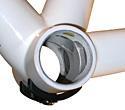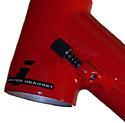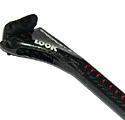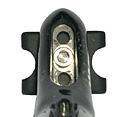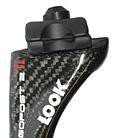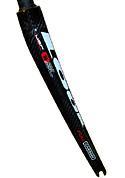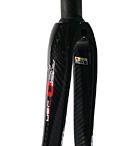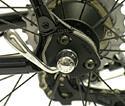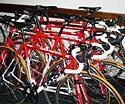
Recently on Cyclingnews.com |
On test: Look 481SL frameset, June 24, 2005
Well worth a closer Look
They say you can't teach an old dog new tricks, but you can certainly give him new toys. Rufus Staffordshire throws a leg over Look's classy 481SL, and comes away very impressed.

|
If I had to come up with a two-word description for Look's 481SL, I'd say 'classic carbon'; it uses much of the latest technology developed by cycling's composite innovator, but retains many traditional qualities that experienced riders look for in a bicycle frame.
In 2005, the 481SL now sits alongside other models like the sub-kilo 585 as one of the company's top racing bicycles. But with its relatively long history (for composite bikes at least), the 481SL certainly has many traditional features and could now be considered a modern classic. The tubeset for the main triangle is waif-like compared to other composite bikes, and the elegantly thin seat-stays evoke hand-made steel frames of the past.
First released in 2004, the 481SL is the evolutionary model of the company's former flagship bike, the KG381i, which had just the odd race victory to its credit. In turn, the 381 had evolved from earlier models and so on.
I'm sure you still remember the name 'Jalabert' and in case you forget, it's written on both sides of the SL's top-tube. Yes, this is the Jalabert frame, and it shows every quality of a bike that the classy Frenchman needed to tear up the roads of Europe. Does anyone recall 'Jaja's' extraordinary solo attacks to bag the climber's jersey in the Tours de France of 2001 and 2002? It was like he was on a separate race-time and agenda to the rest of peloton.
That was then. In 2005, the evolved 481SL features some of the composite technology of the new sub-kilo 585 model, but with real-world creature comforts. Or, as one retailer said, it's "perhaps Look's finest true road racing bicycle".
And that is particularly true if you started your racing - or serious riding - on steel bicycles. Until I'd ridden the 481SL, I would argue nothing is as compliant as a lightweight steel bike, but you'd pay for it in loss of energy due to the frame's flexibility. On the other hand, it can also mean you'll come to the finish of a race or ride somewhat fresher than others who may be completely buckled by their aluminium bikes' uncompromising rigidity.
Well, the Look has achieved a great compromise between rigidity and comfort. If you'd been holding back on lashing out on a carbon job - applying the view that they're stiff as buggery, too tight, twitchy and plain old ugly - then your machine is waiting.
While the 481SL is an evolutionary model, it could be, perhaps, too understated. An Italian bike will scream "Hey! Check me out!"; whereas the Look has quietly evolved into an extremely capable and adaptable bicycle, one that has been ridden to many victories and podiums of the world's biggest races.
Laidback charm
Look is definitely not a 'one set of angles for the whole range' bike manufacturer. Close examination of its line shows a range of frame geometries offered, with the bicycle's specific intention driving the design. This is not just for chrono and track bikes, but for all its road bikes.
And here the company stands alone as being the only manufacturer to offer a thoroughbred racing frame with a 72.5 degree seat angle.
As one famous French cyclist once said, "Ergonomics teaches us that for road riding it's more efficient to pedal 'at the back' with a sizeable setback of the saddle". That was five-times Tour de France winner Bernard Hinault, who had a close association with Look in the 1980s. It would seem that even in 2005, some of (if not all) of Look's bicycles are consistent with Hinault's philosophy.
Hinault's bicycles evolved over his racing years to have increasingly relaxed seat angles and indeed, many of the custom bikes made for today's pros also follow suit.
While most cyclists can fit 'standard' geometry bikes - meaning they have a seat angle of 73 degrees or higher (ie, tighter) - I have always thought that even more riders could be accommodated if those angles were more relaxed.
A cyclist can always slide the saddle forward to get further over the bottom bracket, if that's what is required. Further, I've never heard anyone say, "if only I could get my saddle more forward", unless they were trying to cheat UCI regulations, using it solely for time trials or were on a bike that was clearly too big. It's almost always the opposite, and almost all riders slide their saddles all the way back, usually up to where the saddle rails bend.
Also, this 'relaxed' approach would also seem more appropriate to what's generally considered cycling's growth market in English-speaking markets - old farts like me. As a retailer put it to me, "they're middle-aged blokes whose knees have gone from too much footy or running, and they buy something they see in the Tour de France and come back six months later as they can't stand being shaken apart, looking for something more comfortable".
These are cycling's modern-day fashion victims. Watching the big races, they lash out on a hard-core, brutally efficient, uncompromising machine they see being used by whippet-thin pro riders. Except they are overweight, relatively unfit and inflexible. But they're scared of anything that could be considered 'comfortable', dare it be seen as 'soft'. These fashion victims can be characterised by constant complaints about their knees and lower back, and will also be in a bad mood, due largely to being uncomfortable.
Let's go back, way back
In response to the need for more riders to sit further back on 'standard' geometry bicycles, there is now a wide range of seatposts offering extra setback. Look is also one of those companies and it offers the Ergopost 2, as fitted with the 481SL.
This is a remarkable piece of kit that could liberate many riders by its generous fore-aft adjustment. While I had a scary experience with the first version of this seatpost design some 10 years ago (trying to get more setback on yet another standard frame), the latest design is very strong.
The Ergopost 2 has a 25.4mm diameter shaft (well, it fits Look frames nicely) heavily reinforced around the cradle that holds the saddle rails, and inside this beautifully-moulded composite construction there are three separate holes for the 6mm Allen-head seatclamp bolt.
With the seatclamp bolt in the first hole (closest to 'bars), the post offers about the same amount of setback as a regular Campagnolo seatpost. Moving the bolt also moves the cradle that supports the rails of the saddle, and the middle hole is some 10mm back, and the third (furthest from the 'bars) yet another 10mm, so there is an incredible 20mm of fore-aft adjustment offered.
As a rule of thumb, this is the equivalent of adding up to 20mm to the length of the top tube of the frame, or, up to two degrees of seat angle!
The only issue I could see with the Ergopost 2 is that it is fiddly to access an unsighted 6mm Allen bolt-head - buried as it is deep inside the composite wonderland - but in return, the range of adjustment is nothing short of phenomenal.
Another excellent feature of the 481SL are the adjustable rear drop-outs. The outer face of each drop-out has an alloy plate that can slide fore-and-aft by up to 15mm; they are fixed to the frame by a pair of 4mm Allen bolts. These are a very nice touch indeed and indicative of the bike's understated class, and versatility.
If your preference is to minimise the gap between the rear tyre and downtube - it can do it for you. On the other hand, you may be attempting to ride over some very rough roads - then you can go for the maximum extension. I set it to a wheelbase that was comfortable yet performed well on local terrain and left it there. But if I was to enter criteriums, or spend very long days on rough roads - I had the answer.
No more Look puns
At first glance, the 481SL 'looks' like a bicycle frame (pardon the pun). The traditional triangle is retained, and the tubes are very thin, compared to the meaty triangles of almost every other carbon bike on the market. It's only when you take a very close look (sorry) at the frame do you discover the multi-faceted design of the tubes.
Each tube is bonded into round carbon lugs, but then they meld into multiple sides for the length of the tube, tapering back into a perfectly round shape that's bonded to another lug. The shape of each of these tubes is quite unique to its function; the main down tube is flat on top, has two short flat surfaces either side, merging into more rounded-off sides that join on underneath.
That description really doesn't do it justice, as every observer who stopped to admire this frame - and there were many - had to be told to look again at the tubeset. Then the comments really started: "Hey, they're not round! … How does that work? … Wow, that's awesome" and so on.
Look calls this tube design "Oriented Rigidity", meaning the tubes are constructed to provide stiffness in one direction, and compliance in another.
On the road
So, how does it ride? As mentioned beforehand, it is an excellent compromise between rigidity and comfort. It's typically French, like the sporty little Peugeot cars, that somehow maintain suppleness in the suspension, but offer category-leading steering and roadholding.
I could start at the end, and that is, at the end of a normal two-to-three hour ride, when I really don't feel like stopping. It is that good. I had jumped aboard the 481SL after a custom steel bike made from Columbus EL-OS (generally considered an excellent compromise for riders under 75kg).
But it was better, far better. But you'd expect that. The 481SL absorbed vibration and offered a beautifully compliant ride. And it is the bike's relaxed geometry that comes to the fore once you've been on the road for any length of time.
Not only could you sit up to stretch, take on/off sunglasses or gloves or whatever, you could almost compose an email on your Blackberry. All the time, the 481SL would point dead ahead, float across ripples in the tarmac with only the slightest shake of the head, and continue in a straight line.
Obviously, you need the correct adjustment on the headset bearings, but that is such a simple task these days - compared to old-style lock nut headsets - and it doesn't require special tools.
A bike that almost steers for itself and doesn't over-react makes for very enjoyable days out on the road. If that doesn't make life easier on the bike, what can?
Admittedly, with this set-up, it is no crit-bike. But as a serious road-racing frame when there will be bumpy roads ahead, lots of climbing and technical descents? Absolutely.
Its ability to absorb road vibration, take the edge off bumps and keep steering straight ahead, was first-class. I would certainly argue that its comfort level is so good that at the end of say a four or five hour road race, you'd be in better shape than if you were riding anything else.
On the other hand, it didn't have the instant, even harsh responsiveness of a Columbus Starship (or similar) aluminium frame, but what it gives up in that initial response from stationary, it more than compensates for after the first kilometer of typical chip-and-seal country road.
And once you are mobile, the bike does respond to brutal 'this-will-test-it' accelerations (or at least the best your reviewer could muster). On one occasion, trundling along at 40kmh, I was swept up by a bunch hitting 70kmh, winding it up for the final kick of their training ride on a major.
So, the Ergopower button went all the way down to the 12 as I jumped out of the saddle and took off in pursuit. All the while, the Look tracked true and never wobbled, even as I hit a corrugation while wrenching the 'bars apart and stomping as hard as possible. I made contact with the group, surprised with the ease that I got on, and it was at that point I thought, "imagine what a really good rider could do on this?"
In fact, they do quite nicely. The 481SL was the frame of choice for Credit Agricole pros like Thor Hushovd during the Spring Classics in April this year. While other manufacturers were rolling out custom jobs for a race like Paris Roubaix, Credit Agricole mechanics simply extended the wheelbase using the very clever adjustable rear drop-outs. This also improved clearance with the seat-tube in case the mud really started to build up.
Other bits worth mentioning
The bike was tested with Campagnolo's middle-of-the-range Centaur groupset (in nice, anodized grey) and Proton wheels shod with Michelin tyres, and all of it perfectly matched the bike. You could train and race all year on it.
The 481SL weighed in at 8.1kg with this very 'sensible' groupset and wheels, so lighter bits would make it quite feathery. At 1445g this isn't a featherweight frame, but that's partly compensated by the 300g HSC5 SL fork, and it's well worth putting up with a few extra grams for the 481SL's handling, fit and versatility.
I had a 110mm Ritchey WCS stem and 42cm 3T handlebars (shallow drop) fitted and they complemented it nicely, but the real prize was at the rear; the fizik aliante saddle. This seat was so good it almost impacted on my ability to review the bike, such was its comfort, but I'd taken it off my other bike so I had become accustomed to it.
Your reviewer had spent 15 years on Selle Italia Turbo-Matics - the one with the yellow and black end bits - and the Aliante came as revelation. At first I thought it may have been too soft, and time will tell if it can stand the same treatment as an old Turbo, but from what I've asked of other owners, everyone seems quite attached to them.
Summary
Overall, the 481SL is a very nicely engineered bicycle frame. Yes, the technology comes at a price, but Look's background in making bicycles from composite materials is second-to-none; it clearly knows the material.
It also offers a five year guarantee on the frame and a quick poll around retailers had found that the frames had offered excellent service for their owners. It does have some funky little bits of proprietary kit (the adjustable dropouts and seatpost clamp) that may need replacing, but at least you'll know the parent company is more than likely to have them in stock - and to take pride in that you're still riding one of its products.
The frame skillfully balances the very fine line between comfort and performance, but with an obvious leaning towards the former (with real-world benefits). While a gorilla may claim it's not stiff enough, a classy and intelligent bike rider like Laurent Jalabert rode this bike's forebear to great success in Europe. In 2005, it's still being ridden by many professionals.
However, it may require years and years of being pounded mercilessly by super-stiff frames to fully appreciate a bike like the 481SL. If you're looking to go well under 10 kilos for your next bike, but have been put off by compact geometry or the prospect of losing your fillings, a traditional frame is likely to appeal. If you want it to combine the best of proven modern composite technology yet keep an eye on cycling's traditions, then look no further than the 481SL. Pun intended.
Typical retail prices: USA - US$2700; Australia - AUS$4299
Pro: Versatile European stage-race frame that perfectly balances comfort
and performance
Con: Weight weenies, look elsewhere
Cyclingnews Rating: ![]()
More information: Manufacturer - www.lookcycle.com;
US importer - www.lookcyclesusa.com




